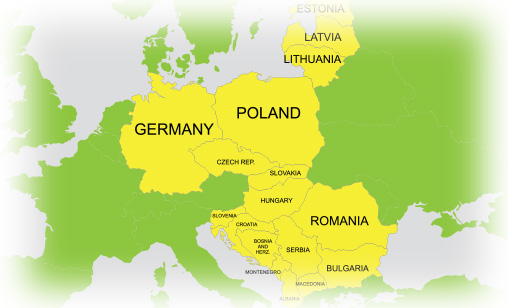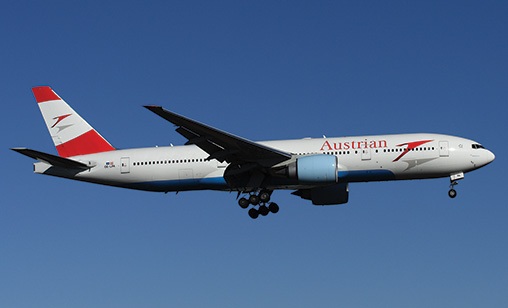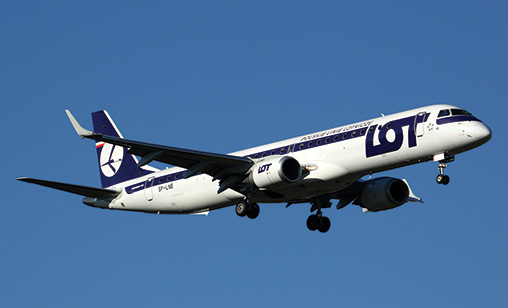News Backgrounder
Opportunities beckoning for Asia’s carriers in Central and Eastern Europe?
Full-service airline appetite for routes into Central and Eastern Europe is curbed by low yield, leisure heavy passenger traffic, presenting an opportunity for Asia’s LCCs to enter the market, reports Tomasz Sniedziewski.
October 1st 2019
Most inflight maps do not slow information about the area they are over flying between Europe and Asia. Read More » Partly it is because the majority of passengers have limited knowledge of the nations of Central and Eastern Europe (CEE) they are overflying. Secondly, the vast zone from Scandinavia to the Black Sea, between Western Europe and the borders of Asia, is still the “flyover states of Europe”.
But the ambitions and wealth of these CEE countries could change that. Even the names of the CEE: Estonia, Latvia, Lithuania, Poland, Czech Republic, Slovakia, Ukraine, Austria, Hungary, Romania and Moldavia depart from the label of Eastern Europe, a nomenclature that offends many of the 150 million citizens living in the former Soviet bloc.
 |
Latest available figures report the CEE’s share of the European airline passenger market is 14.3% or 1.9 million seats a week. Total CEE traffic represents 8.5% of European demand.
In 2017, there were 149 million passenger journeys. On average, CEE citizens fly once a year, 50% less frequently than Western Europeans.
The biggest of the 66 CEE airports, Vienna, has yet to make it into the top 20 Europe airports, reports the Aviation Market in Central and Eastern Europe, published by Rynek Lotniczy.
“While the market between Asia and Europe is prospering in general, CEE is below the market average in demand, yields and capacity. The biggest challenge is low outbound demand from the CEE. It grows as routes are added.
“For example, traffic to Singapore from Warsaw mushroomed after LOT launched a direct flight. However, it is still substantially smaller than demand from East Asia, driven both by leisure passengers and business traffic,” he said.
“Yields are substantially higher on itineraries originating from East Asia than from the CEE. With South and Southeast Asian traffic, with the partial exception of Singapore, demand from CEE is very price-sensitive.”
“Competition from the Gulf carriers, Turkish Airlines and Aeroflot is strong so yields are even more depressed,” said ch-aviation and Polityka Insight analyst, Dominik Sipinski.
“The present numbers mean any Asia-Pacific carrier contemplating opening routes to CEE needed to accept the market’s asymmetric demand - higher in their home markets and lower in Central Europe. Needless to say, most airlines have gone elsewhere for network expansion.”
But the gap is narrowing. According to many analysts, CEE is becoming an attractive market opportunity.
 |
Statistics reveal the increasing wealth of the CEE region and the popularity of international travel is translating into steady upward growth for CEE airlines and the region’s airports.
In the first six months of this year, Vienna Airport processed 14.7 million passengers, 24% higher than in the same six months a year ago.
Other CEE airports, including Kiev (+20 %), Bucharest (+ 8%), Budapest (+7.5 %), Warsaw (+7.4 %) and Prague (+4.7 %), are reporting increases in passenger demand, said Pasazer.com.
Local CEE airlines are benefitting from their geography. Apart from the Lufthansa Group, owner of Austrian Airlines, the region is free from the big airline groups.
A shining success story is the Hungarian LCC, Wizz Air, owned by private equity group, Indigo Partners. Since it started operations 15 years ago, the airline has grown into one of the biggest carriers in the CEE.
Wizz has a fleet of close to 120 A320 family aircraft and double that number of airplanes on order. Another contender of significance in Europe, airBaltic, has carved out a dominant position in Latvia, Lithuania and Estonia, nations of the Baltic States.
Three CEE airlines offer direct flights to Asia. Austrian Airlines flies from its Vienna hub to Beijing Capital, Shanghai Pudong, Tokyo Narita and Bangkok Suvarnabhumi.
Ukraine International Airlines, operating in a politically unstable market where residents travel an average of 0.4 times a year, successfully connects Kiev with Bangkok, Beijing, Colombo and Delhi.
LOT Polish Airlines, a Star Alliance member that aims to be the “the favorite carrier of the CEE”, has scheduled flights from Warsaw to Beijing Capital, Tokyo Narita, Seoul and Singapore.
LOT has added Delhi in September, Beijing Daxing in October, in addition to existing flights to Beijing Capital, and seasonal flights to Colombo from November. It recently inaugurated direct Seoul-Budapest services.
| Mainland airlines testing traveler interest in Central and Eastern Europe In recent years, the presence of Chinese carriers flying into CEE destinations has increased. Airlines from the Middle Kingdom are present in many hubs in the region, although analysts said they are not much competition to their rivals from Asia. “The expansion of mainland Chinese carriers to Europe certainly changes the market dynamic, although they remain largely focused on Western Europe,” said analyst Sipinski. “Traffic to Prague and Budapest is heavily geared towards Chinese group travel and is sold in China by package operators. Going east, demand from Europe is much lower. As capacity from Mainland carriers grows, they will expand their connecting offers, creating competition for airlines from Hong Kong, Taiwan, Japan and Korea. “Southeast Asia is predominantly served by the Gulf’s Big Three, Turkish Airlines and Aeroflot on connecting itineraries. The expansion of Chinese airlines is less disruptive to this market.” Market share evolution on routes between China and the U.S., planned airport infrastructure projects in China and the recent declarations by Chinese carriers that they will participate in the Belt and Road Initiative, emphasize the fact Chinese airlines could play an important role in CEE. “In the longer term, when Chinese airlines broaden their customer bases beyond predominantly leisure traffic, they can disrupt the East Asia-CEE market more,” Sipiński said. |
LOT is not the only carrier to bet heavily on the growth of CEE aviation. In 2018, the Polish government approved construction of an airport outside Warsaw, Poland’s capital. The gigantic intermodal hub will be called the Central Communication Hub.
It plans initial annual capacity of 45 million passengers when it begins operations in 2027. The International Air Transport Association (IATA) has established an Airport Consultative Committee to support the hub’s construction and operations.
“It is not just an airport. We are talking about the hub for intermodality. It is a unique opportunity to do something I don’t think we have done in Europe for the last 50 years,” IATA’s VP Europe, Rafael Schwartzman, told media.
So far, Poland is the only greenfield project of such scale in CEE, but most of the region’s major hubs, including Vienna, Prague and Budapest, have completed or are planning major expansion.
Better infrastructure means greater opportunities for local carriers to build markets. “The CEE is the eastern outpost of the EU. It has the geographic advantage of being the gateway to Europe. Located largely within the Schengen Area, it could be seen as having better intra-EU connections than Moscow or Istanbul,” said Sipinski.
“Given the substantially stronger Lufthansa Group presence in CEE, compared with Air France-KLM or IAG, Star Alliance carriers on the Asia-Pacific side have a slight advantage over their rivals from other alliances. Finnair, which focusses on the North Asian market, also is strong competition.”
Some carriers from Asia are present in the CEE, especially in Austria, the richest economy of the region. Austrians take an average of 3.2 flights a year. Vienna services Asian airlines, including China Airlines, EVA Air, Thai Airways International, Korean Air, All Nippon Airways, Air China, Air India, China Southern Airlines and Hainan Airlines.
 |
For passengers from other countries in the region, the first and often dazzling experience of the standard Asian airline flight was being marketed in competition with the Gulf carriers’ expanding presence in the CEE.
“The Gulf carriers have invested in marketing in the CEE and have very good brand recognition in the region. Combined with generally lower fares, it gives them a strong incumbent position,” Sipiński said.
“The quick off the mark Middle Eastern carriers, now established as brands in the CEE, are tough competition for Southeast Asian airlines eyeing expansion to the CEE.
“In particular, Emirates, flydubai and Qatar Airways have a very strong position in the CEE-Southeast Asia and CEE-Australia connecting markets. Connections via the Gulf are, by the virtue of geography, less appealing for passengers flying to northern China, Japan and Korea.
“The Gulf carriers cover all bases. Cheap economy class tickets, sizeable and high-quality business and first class capacity and large cargo capacity. They are very substantial competition to carriers from Southeast Asia and to a lesser degree from Hong Kong and Taiwan.”
Recently, the Middle East carriers have been going through a transition with many price-sensitive CEE passengers complaining the fares offered by the big three Gulf carriers are not as attractive - read cheap - as they were a few years ago. The discontent has created space in the market for cheap flights to Southeast Asia from the CEE.
Some carriers declare they are happy to fill the gap, including AirAsia Group CEO, Tony Fernandes. The flights, if they go ahead, will be operated by LCC Thai AirAsia X using new A330neo fitted with business class and a high density economy seat configuration.
Flying time between Bangkok and CEE is around 10 hours, which means round trips can be accomplished in 24-hour blocks.
The AirAsia Group joint venture may not be the only carrier planning to fly to Prague. Vietnam’s Bamboo Airways has confirmed it will introduce Hanoi to Prague.
The strategy, with some adjustments, might work, Sipiński believed. “Long-haul low-cost flying is a market niche nobody has quite figured out. Southeast Asia seems like a no-brainer for these kind of routes given the dominance of leisure traffic, low yields and the general reluctance of full-service carriers to expand to CEE,” he said.
“At the same time, a classic low-cost point-to-point product would most likely have to overcome low demand at both points.
“Scoot’s product is an interesting proposition for secondary European markets because it feeds passengers from the regional Singapore Airlines/Scoot network [onto its European flights].
“Other long-haul LCCs would be wise to learn from it and seek to add feeder services on the Asian side. For Thai AirAsia X and Bamboo it could be relatively easy serve their respective home markets with connecting itineraries.”
| Taking a risk in underserved Central and Eastern Europe For the carriers from Asia, the CEE market is a challenge. Although growing, it is still below par compared with Western Europe. The yields are marginal, but the region is closer to Asia and the airline environment is less competitive. “CEE is a greatly underserved and challenging market. Demand for both inbound and outbound travel will grow, but the market is relatively low-yield, leisure-heavy for now,” said analyst Sipinski. “Asian point-of-sales bodes better for carriers than traffic from Europe. It is probably less risky for Asian carriers to add routes to CEE than for CEE to significantly expand to Asia, particularly to secondary markets, “In particular, given the growth prospects for Poland and its geographic location of the country, a stronger presence of a North Asian airline could bring benefits in a few years, although I would not expect the routes to be immediate and substantial money-makers”. For some Asia Pacific carriers, this may be enough to have CEE on their maps. |